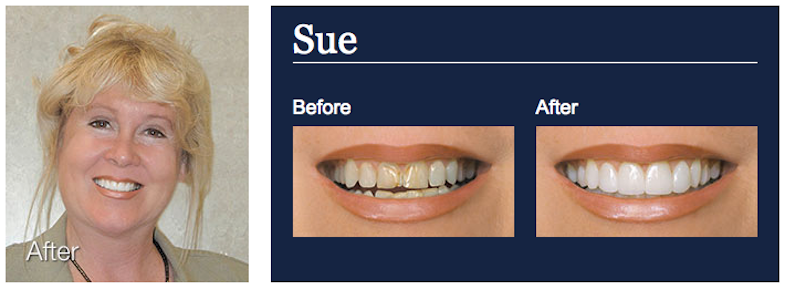As we age, so do our teeth. Sometimes, though, our teeth seem to age us. For various reasons, our teeth can become noticeably discolored over time, resulting in a less-than-bright smile. While whitening strips and other at-home whitening treatments may help temporarily, there are other ways to get whiter teeth that last longer. Veneers have long been an excellent cosmetic choice for a beautiful smile, but newer veneers—Lumineers—take it one step further. Dental Lumineers are a lightweight, non-permanent, and natural way to get whiter teeth.
How do dental Lumineers work?
Dental lumineers can be used for a variety of cosmetic purposes, including:
- Covering discolored teeth
- Filling in gaps between teeth
- Smoothing the surface of teeth with bulges
- Covering chipped or broken teeth
Made of a very thin, hard porcelain, Lumineers are fitted over existing teeth. From start to finish, the entire procedure usually takes three visits with your dentist.
Visit 1: Consultation
Your dentist will conduct a complete exam. There are several types of veneers available for cosmetic dentistry. It’s important to pick the one that works best for you and your teeth.
Visit 2: Fitting
Your teeth will be measured and fitted for a custom set of Lumineers. You may only need one or two Lumineers, or you may opt for a full set for both upper and lower teeth.
Visit 3: Application
The application process takes about an hour. Your dentist will apply adhesive to the front of each tooth receiving Lumineers and will carefully fit them onto each tooth. They may opt to fine-tune the fit so that the Lumineers blend better with neighboring teeth and your gumline.
While dental Lumineers are not considered permanent, with proper fitting, application, and care, they are designed to last up to 20 years.
What are the differences between Lumineers vs. veneers?
Lumineers fall under the broader category of veneers. Veneers have been the traditional tool for cosmetic smile correction for years. As such, they offer some benefits that Lumineers don’t. Here’s what to consider when weighing your option of dental Lumineers vs. veneers.
Alignment issues
As noted below, Lumineers are best for patients who have good tooth alignment to start. They can mask minor issues, but for teeth that are severely misaligned, traditional veneers may be better.
Permanent vs. semi-permanent
Traditional veneers require the dentist to remove some tooth material for proper fit. Because of this, veneers are considered permanent (because you cannot remove them and leave your teeth without covering).
While in some cases dentists may elect to remove some tooth material, the majority of patients do not need to have tooth material removed when getting Lumineers. This classifies dental Lumineers as semi-permanent, as you can technically remove them and return to bare teeth.
Appearance
While both dental Lumineers and traditional veneers offer the benefits of a whiter smile, there is some variation in the final result.
The material of some types of veneers may reflect light better, resulting in a more natural-looking tooth, whereas some people find that the solidity of Lumineers makes them feel like their smile is more solid. When patients are good candidates for both Lumineers and traditional veneers, the choice of which to get is largely a matter of preference.
Feel
Both traditional veneers and Lumineers are customized to each patient, so in time any unusual feeling patients experience should fade.
Because no tooth material is removed with Lumineers, some patients report feeling that their teeth are thicker, especially at the ends and by the gums. Most of these same patients also report getting used to the difference so that it is unnoticeable.
Cost
As with most dental procedures, cost can vary depending on office location, each dentist individually, and how many veneers or dental Lumineers you get at a time.
Some dentists may charge less per tooth if you get more than one veneer or Lumineer at a time. Most medical insurance does not cover the cost of cosmetic dentistry unless it is part of another illness, so talk to your dentist about financing options and payment plans.
Am I a good candidate for dental Lumineers?
Because Lumineers are not considered a permanent alteration of the teeth, many different types of patients can be considered good candidates. However, the best patients for Lumineers share the following traits.
No history of teeth grinding
In addition to wearing down natural teeth, teeth grinding (also known as bruxism) can be damaging to all dental work. The best candidates for Lumineers have no history or evidence of bruxism. This will protect the longevity of your Lumineers.
Healthy teeth with no decay
Covering up existing tooth decay with anything is a recipe for disaster. While Lumineers are a great way to brighten your smile, there is no substitute for the treatment of underlying cavity or tooth decay. Patients with extensive decay may need to explore other options.
Well-aligned bite
Lumineers are best placed over straight, well-aligned teeth with no malocclusion. Minor discrepancies in bite may be masked, but in general, good candidates for Lumineers start with a properly aligned bite.
Even in patients with bruxism, tooth decay, and minor malocclusion, Lumineers may work. The best way to find out if you are a good candidate for Lumineers is to talk to your dentist.
Where can I find a Lumineers dentist near me?
If your smile is less than perfect due to discoloration, chipped or broken teeth, or gaps and bulges, you can use the Lumineers website to find a Lumineers dentist near you.
When choosing a Lumineers dentist, ask about their experience in placing Lumineers and ask to see some examples of their work. They should also be able to talk to you about the materials they use and discuss financing options.
Your Lumineers dentist in Scottsdale is Dr. Janne Lynch; give her a call to schedule a consultation at one of our Phoenix area clinics today!
Image from Lumineers Before & After Gallery
